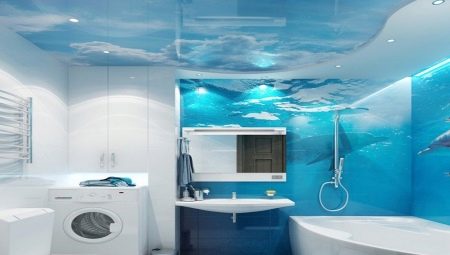The ceiling lining in the bathroom may be different. When choosing a finishing material, a number of requirements have to be considered. This is due to the special microclimate of most plumbing units. From the material in this article, you will find out what features differ in different options and what to consider when choosing a decoration you like.
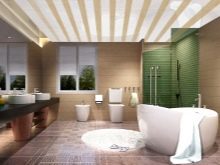

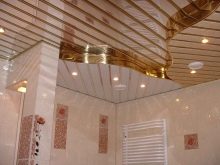
Features
The choice of finishing material for decorating the ceiling depends not only on aesthetic preferences. It is important that it is practical and durable. The bathroom is constantly damp, condensation accumulates here, the temperature often changes. The selected material for the ceiling lining must be inert to moisture.
When bathing, water splashes on the ceiling are not excluded. The coating must withstand this. In addition, the finishing material must be suitable for a particular room. The decisive criteria may be the height of the walls, the size of the bathroom. Finishing should withstand possible leaks from the apartment from above.
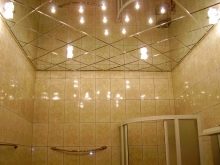
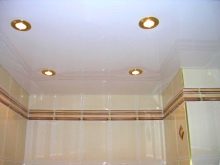
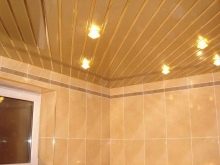
At the same time, the material should be easy to maintain, since it will have to be cleaned regularly. Ideally, if the finish will withstand cleaning with a soft sponge and detergent. You need to choose the option that is suitable for a particular design, has the desired texture and color. Wherein it is important to take into account the status of the interior - appropriate material is taken in an expensive environment.
Other features of the selected finish include environmental friendliness, hygiene and safety. From the list of materials it is desirable to exclude whitewashing, foam tile and ordinary drywall.
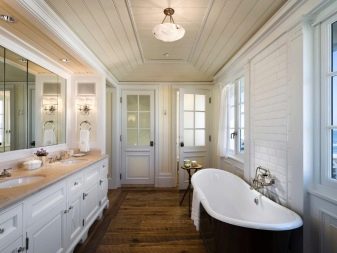
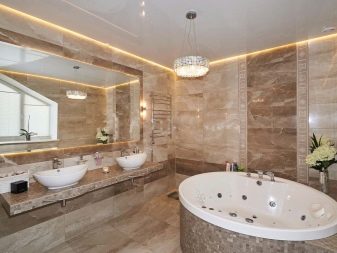
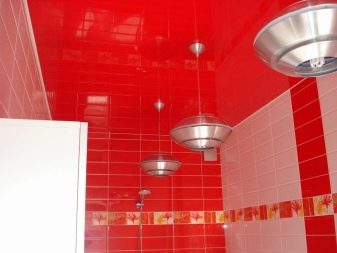
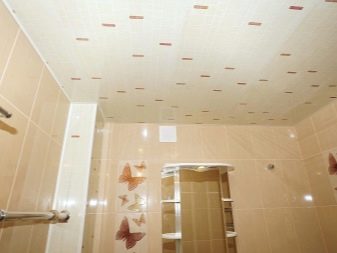
Requirements
A number of requirements are imposed on the choice of finishes for decorating the ceiling of bathrooms. In addition to resistance to moisture, finishing material it should be:
- inert to mold and mildew;
- resistant to corrosion and condensate stains;
- resistant to fading from moisture and light;
- optimal in terms of weight and easy to install;
- suitable for design in a specific interior style.

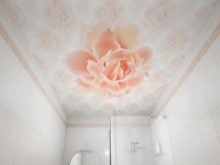
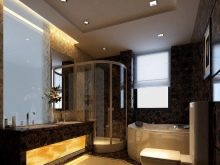
Besides, you need to choose the option that has a safe type of lighting and does not melt when heating mounted light sources.
The ceiling in the attic bathroom with sloping walls should be easy to install. This can be a frameless or frame structure.
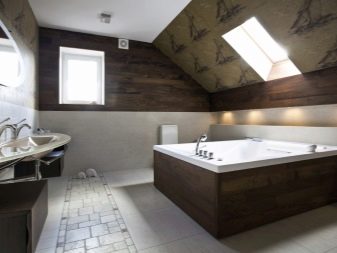
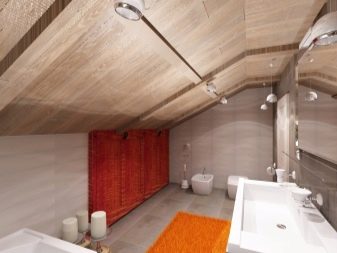
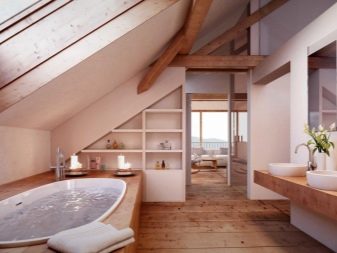
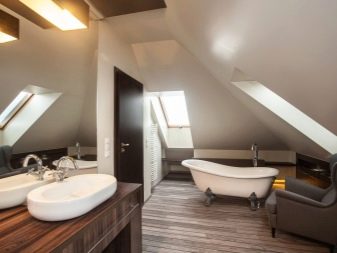
Kinds
Classifications of ceilings can be by type of construction. Suspended and suspended options are considered especially demanded. The coatings of each line have their own characteristics.
Suspension
These designs are frame systems with suspensions. When they are installed, they create a crate to which the finishing material is attached. At the same time, along the perimeter and the entire area, the coating is fixed on suspensions, the length of which can vary. Such options shorten the height of the walls by at least 10 cm, and therefore are suitable for the design of bathrooms with high ceilings.
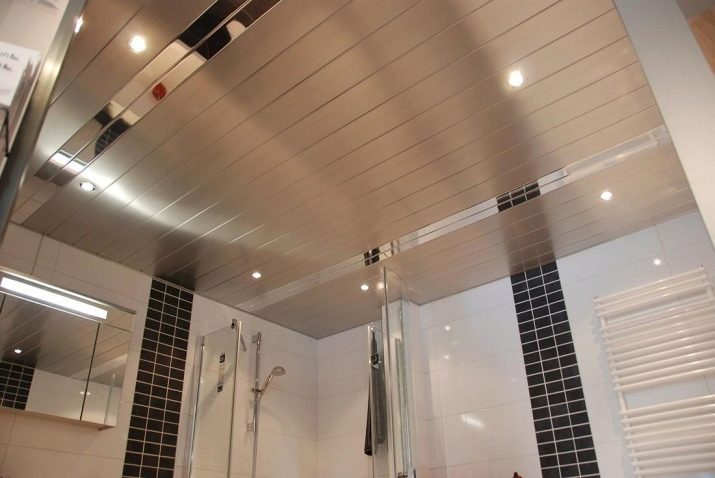
By design, they are ordinary and soaring. The second modifications seem to be suspended in the air. This effect is achieved due to the backlight. Luminous ceilings give the bathroom a special atmosphere.
Options hanging type can be cassette, typesetting or mesh. Their basis can be gypsum fiber, glass, mirror, plastic or gypsum boards.
The latter are made from waterproof sheets of drywall.
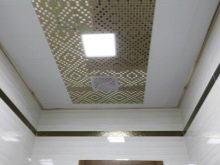
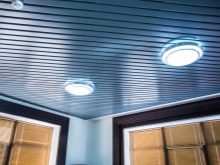
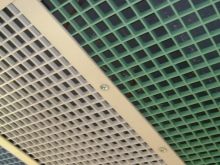
The advantages of such products are:
- surface leveling;
- wall height adjustment on a vertical plane;
- no need to level the base;
- the ability to install sound and heat insulation;
- embedding lighting and top lighting;
- variety of design;
- aesthetic appeal and accuracy;
- the ability to replace the finishing material without replacing the frame.
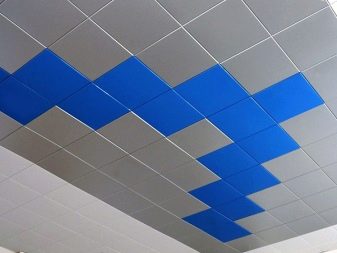
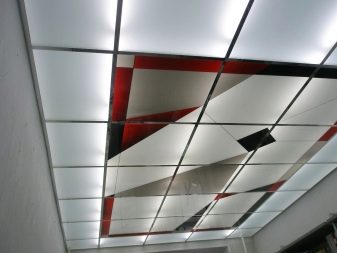
Along with the advantages, suspended ceilings on a metal or wooden frame have disadvantages. For example, they do not protect the bathroom from leaks. With poor ventilation, mold forms between the finish and the base. Some of the designs are completely impractical for small plumbing assemblies.
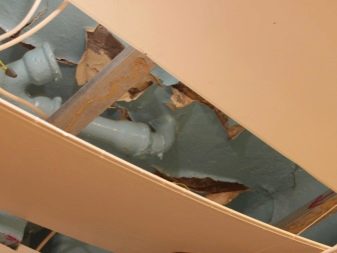
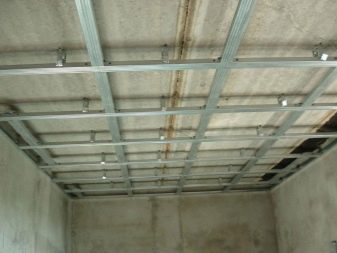
Tension
Stretch-type ceilings are considered the best solution when choosing finishes for bathrooms. They are durable, not too complicated to install and are distinguished by their tensile ability. Such designs are elastic film stretched on a wooden or metal frame. A significant advantage of suspended ceilings is bilateral moisture resistance.
They are waterproof, do not deteriorate in case of leaks, taking their original shape after removing water. The polymer material can withstand 100 kg of weight per 1 sq.m.
The texture and color of the film may vary. The film is satin, glossy and matte. It can be applied photo printing, it can be combined with other finishing materials.
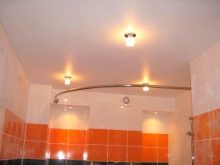
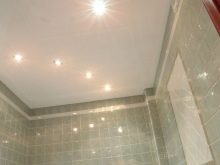
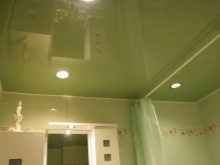
Such ceilings have many advantages. For example, they are distinguished by:
- ease of care and removal of various kinds of pollution;
- the ability to mask the ceiling base;
- no need to level the base;
- minimum loss of wall height (about 5 cm);
- design variability and variety of color schemes;
- variability of width, seam and seamless types of panels;
- reasonable cost.
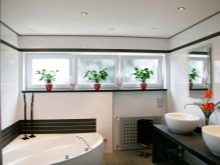
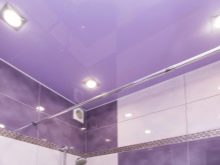

The film is considered a universal material.It can be combined with ceiling panels, siding, cassettes, battens and plasterboard structures.Different types of luminaires can be embedded in such a coating, which makes it possible to create not only ordinary, but also luminous structures with an original design. The stretch fabric dampens sound waves, reducing the noise level coming from the apartment from above.
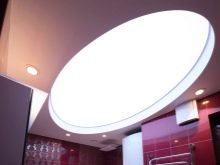

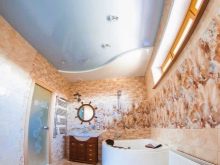
In addition to the advantages, stretch ceilings have several disadvantages. For example, to install them heat gun needed. Before tensioning, you need to heat the film, and therefore special equipment is indispensable. It is important to cut the material correctly - if the canvas is cut off without allowance, you will have to buy a new one.
Despite the high quality of the film, It is unstable to mechanical damage. Cuts are not subject to adjustment, such a coating has to be dismantled.
A disadvantage is the gradual yellowing of the film at the location of the lamps.
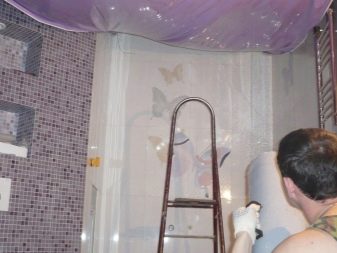

Finish options
Finishing materials for decorating the ceilings of bathrooms are different. Depending on this, their strength and operational characteristics differ.
Stucco and whitewash
Both facing materials are rarely used in bathrooms due to their impracticality. Whitewashing is susceptible to temperature and humidity conditions in the bathroom. Such a coating becomes unusable too quickly. And if the fungus is masked by whitewashing, then it also falls off from the problem base.
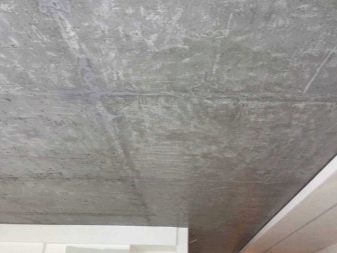
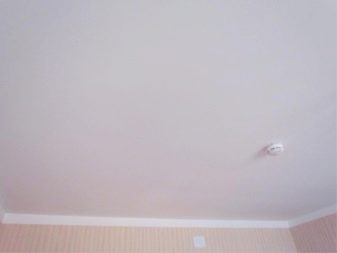
Despite the fact that on sale you can find waterproof plaster it only briefly eliminates minor irregularities and cracks in the base.
The ceiling does not look fresh as long as we would like, and therefore the issue of re-lining in a particularly wet bathroom arises quickly.
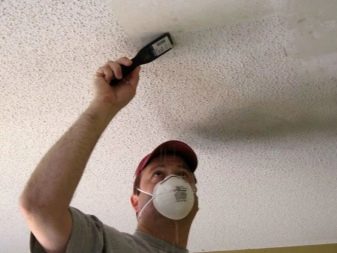
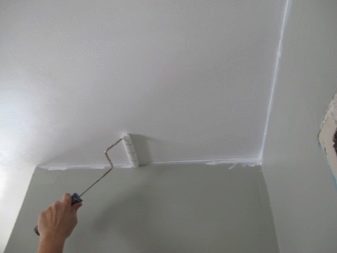
Among the advantages of these finishing materials can be identified environmental friendliness and affordable cost. Facing work can be done independently, without spending money on attracting outside specialists. However, the disadvantages of the materials are more:
- such ceilings look too simple;
- they need preliminary preparation of the foundation;
- over time, the treated surface turns yellow;
- from constant splashes and sagging on the surface, stains remain.
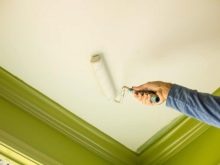
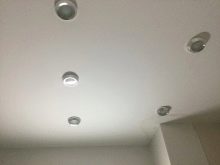
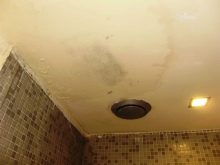
Painting
Ceiling painting is considered another budget type of design. The disadvantage of this coating is the need for thorough preparation of the foundation. Without this, the ceiling looks untidy. It is inconvenient to paint the ceiling: the paint applied to the roller drips down, solidifying and forming bumps. If you cover the ceiling with a thick layer, a beautiful coating will not work.
Apply paint to a prepared base. The preparation includes a list of works on masking cracks, chips, removing bumps, strengthening the ceiling with a primer with an antiseptic. The work uses paints based on latex, acrylic, silicone and silicate. The advantages of painting include reasonable cost, the possibility of independent work, ease of care.
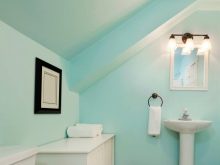
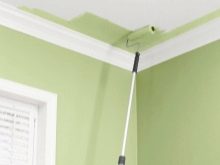
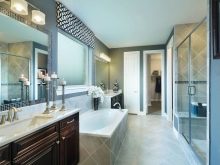
It’s good that such a finish does not conceal valuable centimeters of the height of the walls.
However, over time, the paint fades, and the white also turns yellow. Such a coating cannot be called aesthetically attractive. In conditions of constant dampness, mold may form on the painted surface.

Wallpaper
This type of finish is considered controversial, despite the fact that the materials are resistant to moisture. Not every type of wallpaper can be used for gluing: only vinyl and glass wallpapers are suitable for this. Materials of the second type provide for painting up to 20 times. They do not deteriorate from moisture and can have the most diverse type of texture.

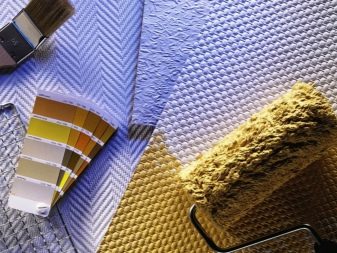
Textured cullets are perfectly combined with any finishing material for walls and floors. They can convey the texture of matting, stone and decorative plaster. Due to the large meter width, it is easier to work with them than with traditional roll counterparts. However, sticking wallpaper on the ceiling is much more complicated than on the walls.
In addition, the work requires quality foundation preparation. We have to plaster the coating, masking cracks, chips, getting rid of the tubercles. To enhance adhesion, it is necessary to cover the ceiling with a primer. It is impossible to glue wallpaper alone - they will fall off the ceiling. It is more difficult to combine the joints, as well as align the panels so that they lie flat.
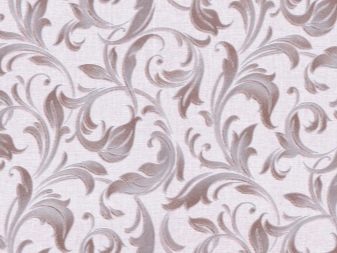
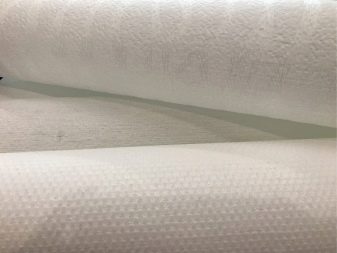
Tile
Tile is a standard facing material for decorating ceilings of small plumbing assemblies. Often, it is chosen for facing the ceiling in the area of an open shower. The tile is inert to moisture, it does not deteriorate from condensation, does not fade and is durable. On store shelves it is presented in a wide assortment.
A variety of colors and textures allows you to choose an option that emphasizes the recognition of a particular interior style. The shape of the material may be traditional. square, rectangular, triangular, diamond-shaped, hexagonal and even octagonal. However, this type of finish has its drawbacks. Working with it is very difficult, given that the cladding will have to be done on the ceiling.
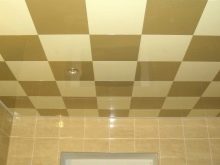
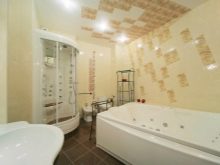

Finishing it yourself will not work, will have to invite a specialist who will make a monolithic coating without shifting the seams and changing the inclination of the facing plane. The disadvantages of the tiles are fragility to gluing and instability to mechanical damage during transportation to the place of work. In addition, the “sore spot” of such a coating is the inter-tile seams on which any dirt is visible.
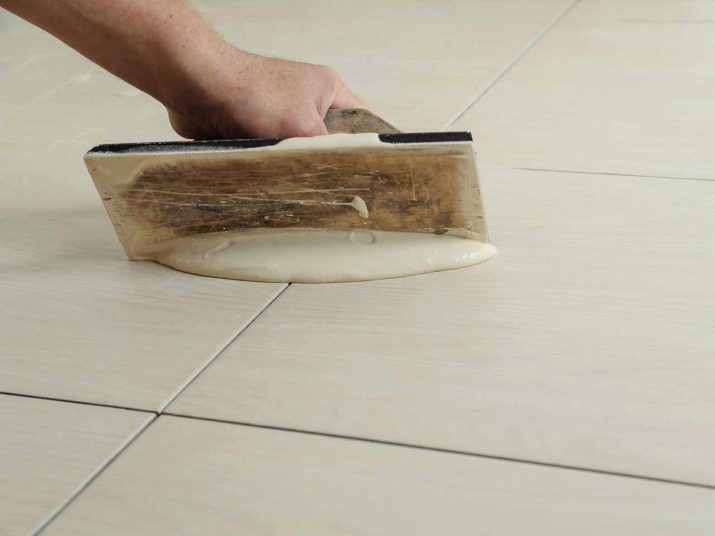
Glass
Glass ceilings have the ability to visually increase space. They are especially appropriate in small bathrooms, such ceilings bring a certain lightness and airiness to the atmosphere of the room. These are suspended structures consisting of glass plates laid on a metal frame.
The installation of this cladding is carried out in an optimally fast time. There is free space between the ceiling and the material itself. However, this type of cladding is not so easy to care for. The smallest stains and traces of water spray are visible on the glass surface.
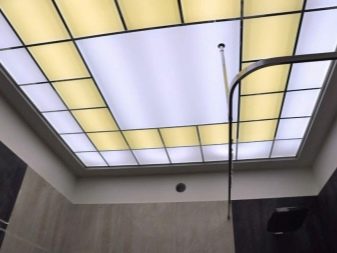

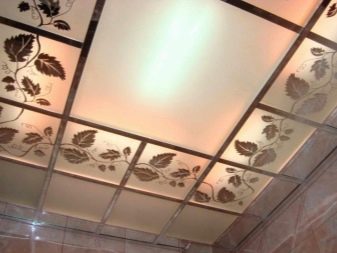
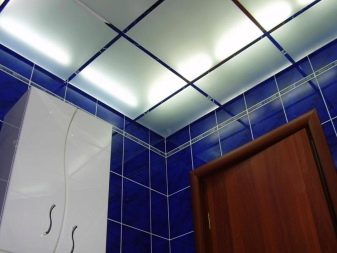
Mirror
This finish is material with a mirror texture coating. These are mirror panels that are attached to the metal frame using special glue. Reflective finishes can be made of different materials. Budget facing materials are made of plastic. They are lighter than classic counterparts, easier and cheaper to install.
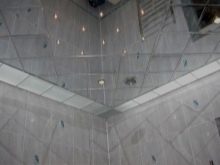
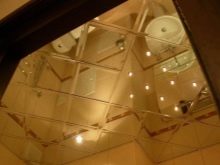
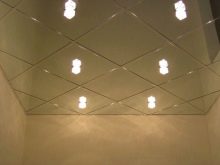
The positive qualities of mirror cladding materials are:
- doubling the level of illumination of the sanitary unit;
- the high cost of the appearance of the finished cladding;
- moisture resistance and an extraordinary look.
The disadvantages of facing with a mirror texture include inability to retain moisture in case of leakage from the upper apartment. In addition, the care of this surface is complicated.
Any dirt is noticeable on it, it is necessary not only to clean it, but also to polish it. It is also bad that installing mirror cladding on your own is impossible, and this is a cost to pay for the work of the craftsmen.
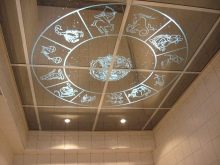
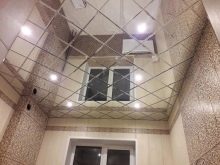
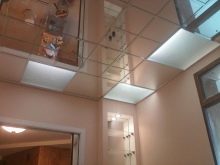
Siding
Siding is a paneling made of different materials. Today it happens plastic, metal, acrylic, fiber cement, ceramic, wooden. This finish not only decorates, but also protects the ceiling from external influences, increasing the life of the decorative coating.
Such panels are relatively durable and fully moisture resistant. Their installation is carried out on the crate (wooden or metal) according to the castle technology. The technique is optimally simple and understandable even to lay people. To make such a cover is possible for any head of the family.
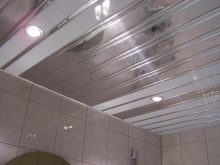
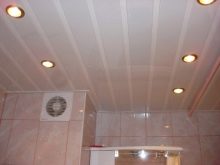
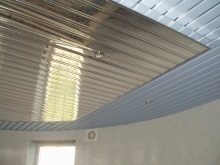
The panels have a wide range of colors, and some of the varieties are able to imitate any type of texture.For example, they perfectly convey the texture of wood, metal, stone, marble, plaster, concrete, mirrors, glass. Care of the coating depends on the material of manufacture. Basically, it does not cause problems and consists in regularly wiping the surface with a dry or wet cloth.
The disadvantage of siding is contamination of the joints. If the room is too damp and ventilation is not thought out, it will not be possible to avoid the appearance of fungus or mold. The advantage is the ease of dismantling. If there was a leak, finding a problem spot on the ceiling would not be difficult. Putting the panels back in place is easy.
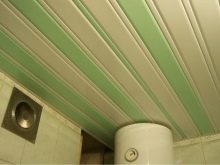
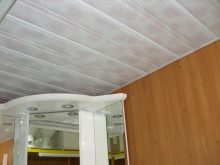
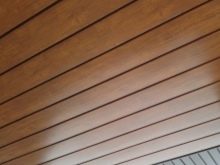
Reiki
Slatted ceilings collected on the frame. They consist of many narrow plank panels, which are made of plastic or aluminum. Their texture can be any, up to gilded, chrome, printed and silver. Such a finishing material is easy to install and maintain, it is flexible, which is why it can be not only direct, but also curved.
The polished surface of the battens is reflective. Due to this, it brings into the space the illusion of spaciousness and lightness. The disadvantage of rails is driving mud into interpanel seams.
If you do not pay attention to them in time, the monolithic coating becomes untidy. It is also bad that rack ceilings are not universal: they are far from suitable for every interior style.
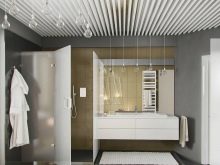
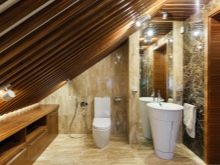
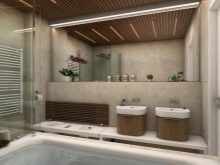
Moisture-resistant drywall
Drywall is none other than a layer of gypsum, packed on both sides with sheets of building cardboard. The ceiling material differs from the wall material in smaller thickness, and therefore does not create a large load on the ceiling. They attach it according to frame technology to a crate made of wood or metal. Moisture-resistant finishing material contains protective additives from fungus and moisture.
Sheets marked GKLV do not damp, do not rot and do not crumble during operation. With their help create one-, two-, three- and multi-level designs, making the interior of the bathroom special. The advantages of such a finishing material, in addition to weight, are:
- compatibility with different cladding;
- the ability to paint and mask seams;
- compatibility with any type of fixtures;
- masking of roughnesses and defects of the basis;
- masking ventilation, communications and wiring;
- durability and esthetic appeal.
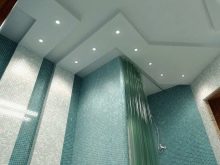

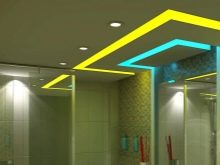
In addition to the advantages, moisture-proof drywall has its drawbacks. For example, one of them is the price of the finished design. The coating has to be putty, primed and painted. Self-assembly is possible if the head of the family has certain skills in working with drywall. If you have to invite professionals, this significantly increases the cost of ceiling finishes.
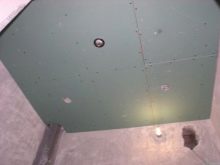
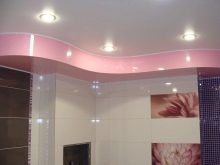

Choosing a ceiling plinth
Ceiling plinth (fillet, molding, baguette) is a decorative elementgiving the finish a finished look. Besides, it hides visual defects on the joints of adjacent planes. Its appearance, width and shape may vary. Manufacturers focus on consumer demand, driven by aesthetics, a high level of decorative solutions and functionality.
Skirting should form a certain style of the interior, give the finish completeness. Its execution may differ in cross-sectional dimensions, configuration and profile design, material of manufacture, colors. You need to choose the option that is easy to cut and fit, has a small weight, allows spot repairs and painting. In addition, it is better to buy a product that does not support combustion.
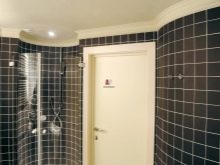
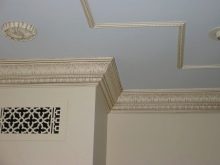

Should I do a multi-level ceiling?
The number of levels of ceiling decoration depends on various factors, for example, the size of the room, the height of the walls, the complications of the layout. If the room is small, a multi-level system is undesirable.Such structures steal the height of the ceiling, so the room seems uncomfortable and visually heavy. In small bathrooms with a ceiling height of 2.4 m, even two-level systems are excluded.
When the room is large and the ceiling is high, multilevel systems are appropriate. However, if earlier multilevel ceilings were considered a fashionable solution, today the number of levels does not exceed two. Stylists note that emphasis in the bathroom should focus on elements of furniture or plumbing. If the ceiling design is complicated, the interior will seem overloaded.
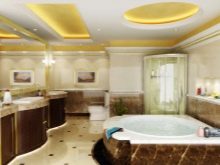
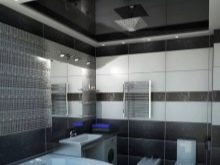
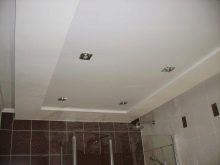
At the same time, when choosing a species, they pay attention to the resources of a particular style. For example, in the interior modern two-level ceilings are indispensable. If the bathroom is decorated in style minimalism, unnecessary complexity to anything. One level is enough to design a ceiling in style loft - The emphasis of the design will be to use beams and decorate the ceiling space with the failed communications.
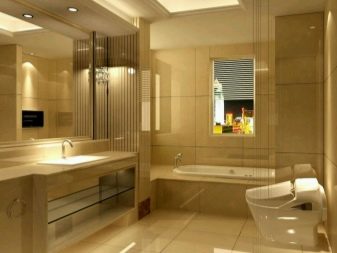

Colors and texture
The colors of the ceilings for the bathrooms are subject to different criteria. For example, the choice of the basic shade may depend on the size of the room, the height of the walls, the presence of windows, the resources of a particular interior style. Ideal tones will be light shades of the color palette. White priority: it visually brightens the space, erases its rigid boundaries, brings a sense of spaciousness to the atmosphere. Besides him relevant milk, beige, whitewash blue, light coffee color.
Black color is not suitable for the ceiling: it visually makes the space heavier, introducing negative notes into it. It is undesirable to decorate the ceiling in acidic and harsh shades (for example, poisonous orange, acid yellow, blood red). The atmosphere in such a bathroom will be annoying and it will not work.


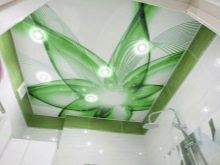
The texture of the cladding may be different. Stylists recommend paying attention to the area of a particular room and design features.. Small bathrooms have glossy ceilings. However, it is necessary to pay attention to the level of reflectivity. For example, in a small bathroom, a mirror ceiling is undesirable: in a confined space, instead of increasing it, it will give a clutter effect.
Matte-coated materials are needed to translate country or provence styles.. It can be slats or plastic panels with imitation of painted wood.
Gloss is not suitable for these styles, but it is indispensable for decorating ceilings in almost all modern interior styles. For retrodesign, in addition to coatings with a frosted effect, finishing materials with a satin surface are suitable.
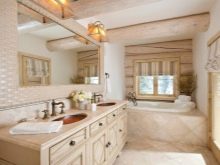
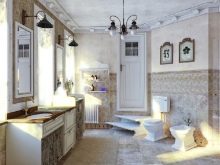

Selection tips
To choose the best option for the facing material for the design of the ceiling, you need to pay attention to a number of nuances. These include practicality, durability, ease of care, level of moisture resistance and aesthetic appeal. If we consider the issue in terms of durability, wallpaper, plaster and whitewashing is best to immediately exclude. Despite their price, such options have more disadvantages.
It is better to decorate the ceiling of the bathroom with stretch film, plastic panels or battens. In extreme cases, you can use moisture-proof drywall. Choosing between one and the other option, you need to consider the compatibility of finishes with elements of furniture and plumbing. If you want to do the design yourself, you need to take an easy-to-install option.
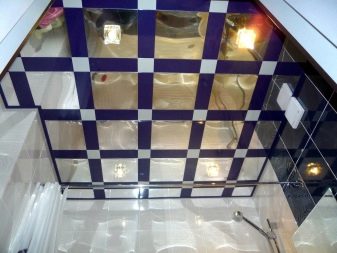
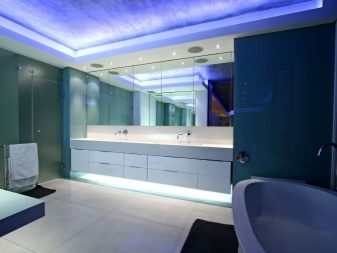
At the same time, one should not forget about the style. For instance:
- for classics, neoclassics, classicism matte or glossy tension film with stucco molding is suitable;
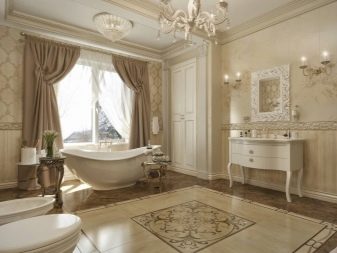

- for minimalism need a single-level ceiling without decor and gloss;
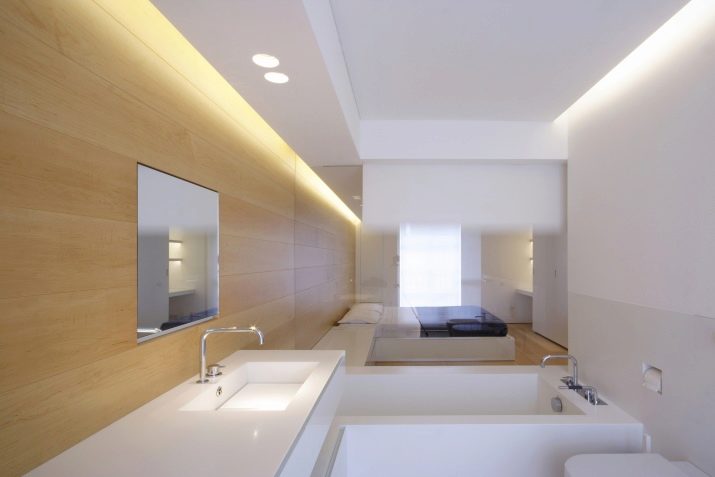
- to style modern combined design with a combination of drywall and glossy or matte film will do;
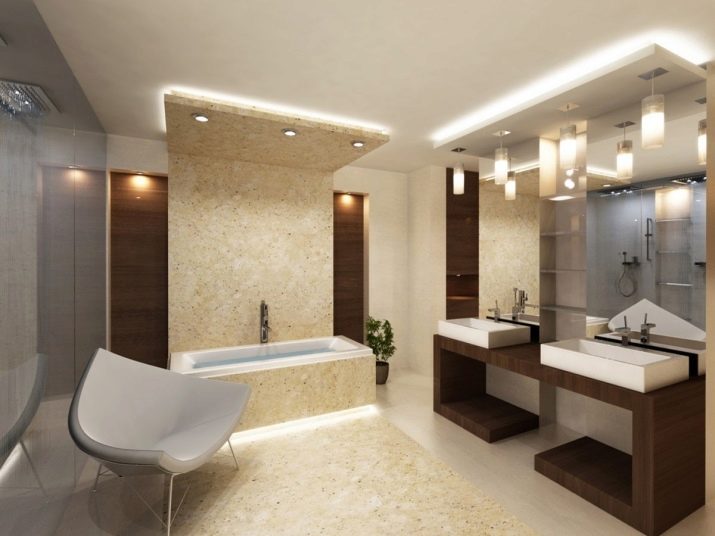
- in style loft a film or plastic siding with imitation of concrete will look good;
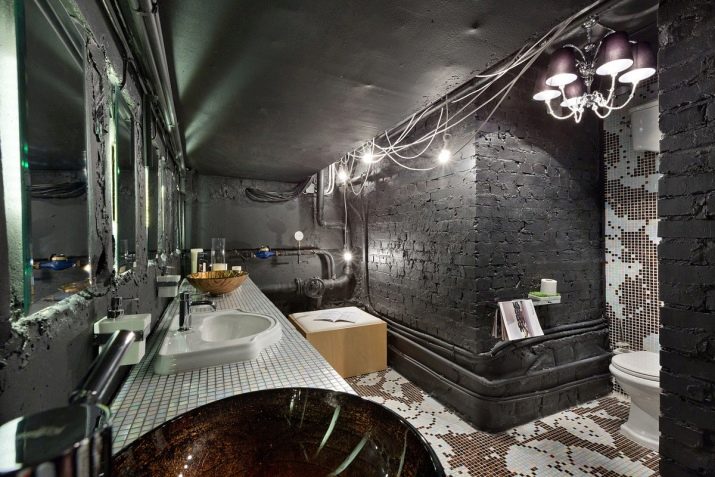
- for bathrooms in club style actual cassette design with a mirror surface;
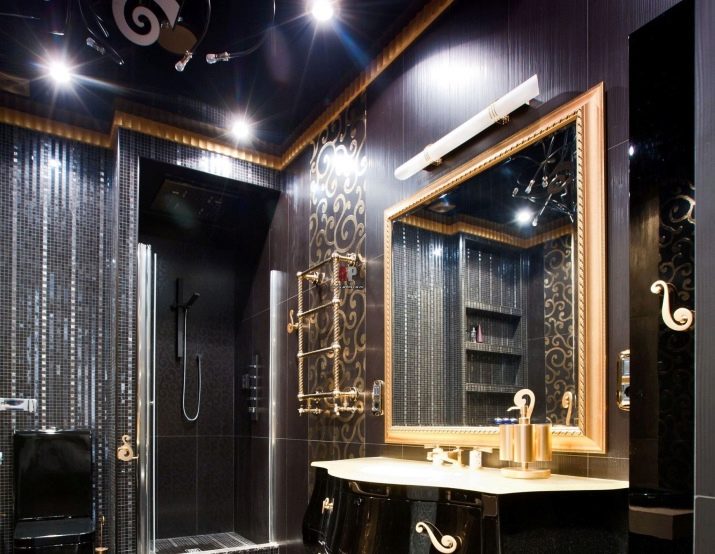
- for scandinavian style need a single-level film ceiling with a matte surface;
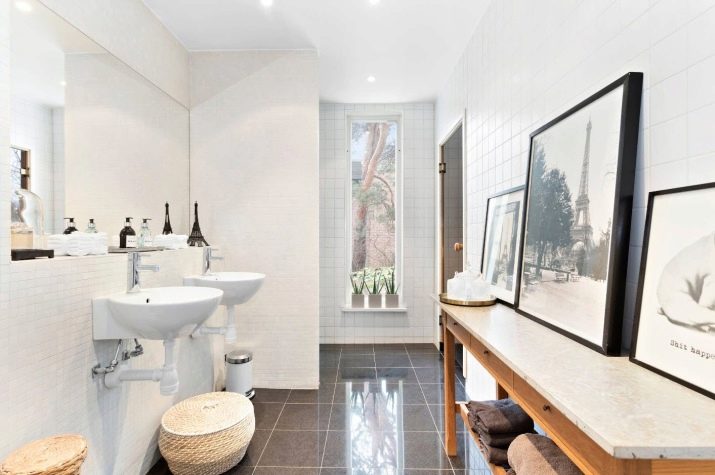
- in eco style you can use the design with wooden slats or plastic with imitation wood;
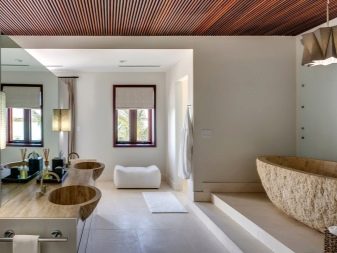
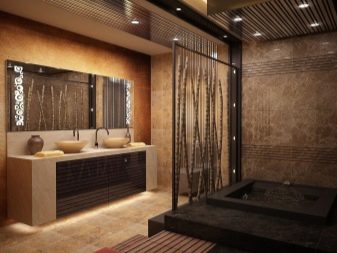
- in styles provence, vintage it is worth decorating the ceiling with battens with imitation of painted wood;
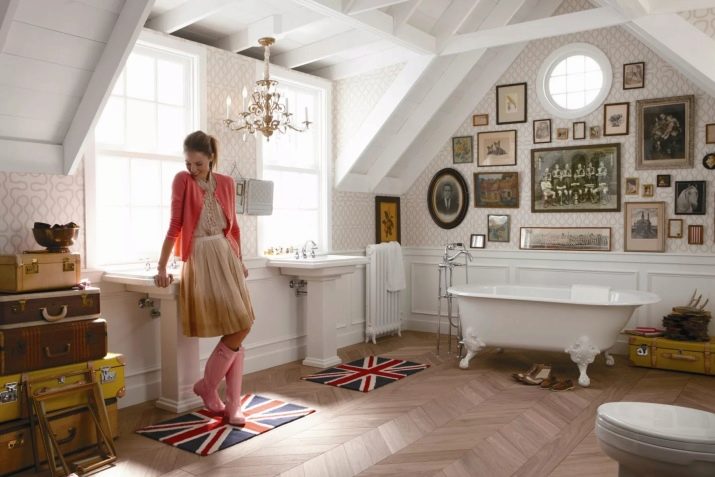
- Art Deco can be designed using a single-color stretch film.
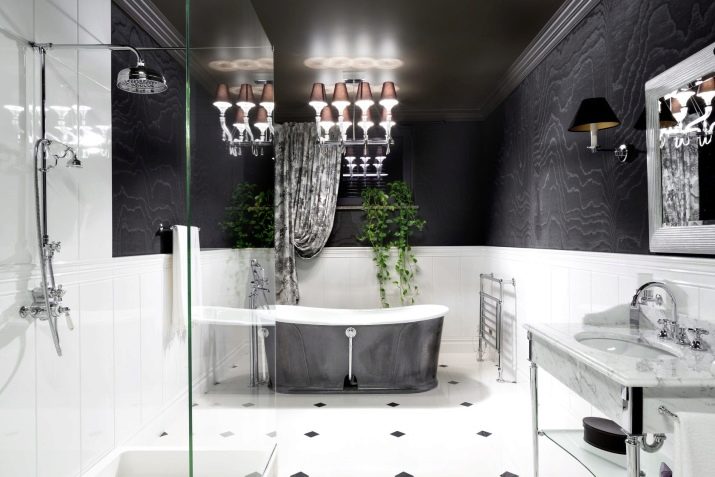
Choosing one or another option, you need to consider the color that is characteristic of a particular style. For example, vintage and provence prefer light, whitened tones. Country colors are warmer. In Scandinavian style, on the contrary, you need light cold shades. In modern areas, they use white, light wood and beige color.
Good examples
We offer 10 successful examples of the choice of finishing material for decorating the ceiling of the bathroom.
Reflective cassette ceiling in the interior of a modern bathroom.
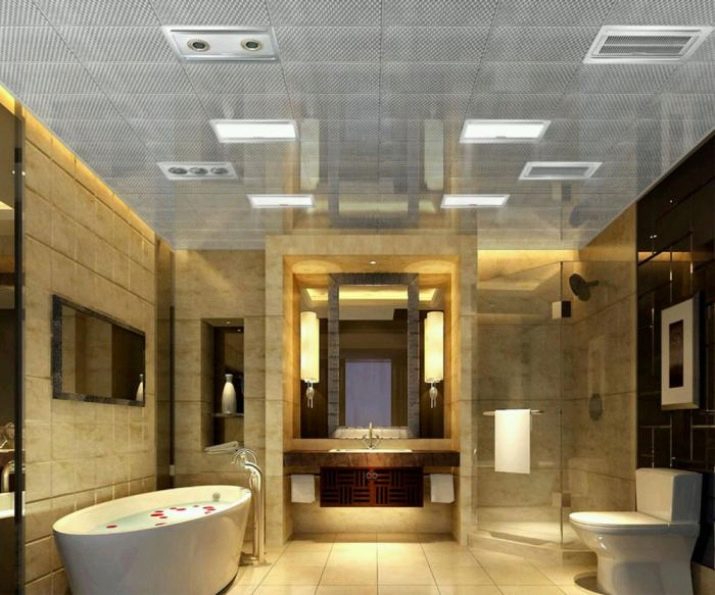
Plastic soaring ceiling with integrated lighting and color LED strip.
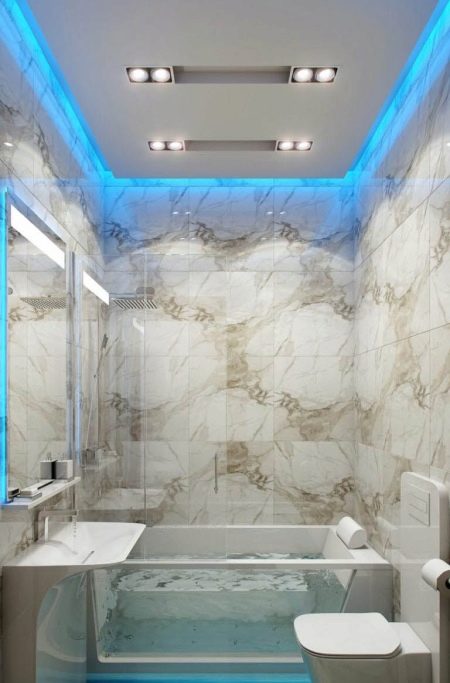
Gold-plated rack ceiling in the interior of a modern bathroom.

An example of the design of the ceiling space with beams and spotlights.
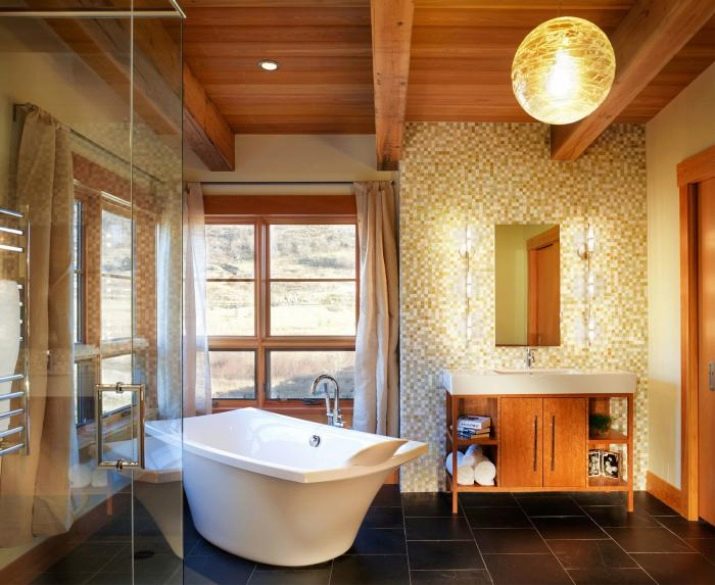
The design of the ceiling, taking into account the methods of zoning: different colors for individual functional areas.

Single-level design with built-in illumination of each functional area.
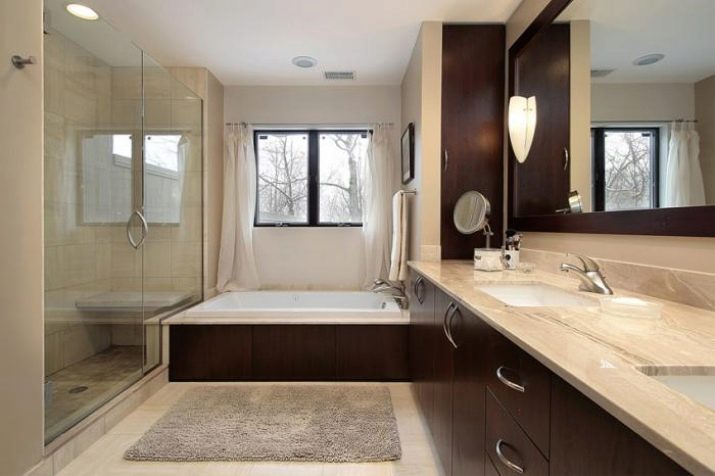
Combined design ceiling space using slats and drywall.
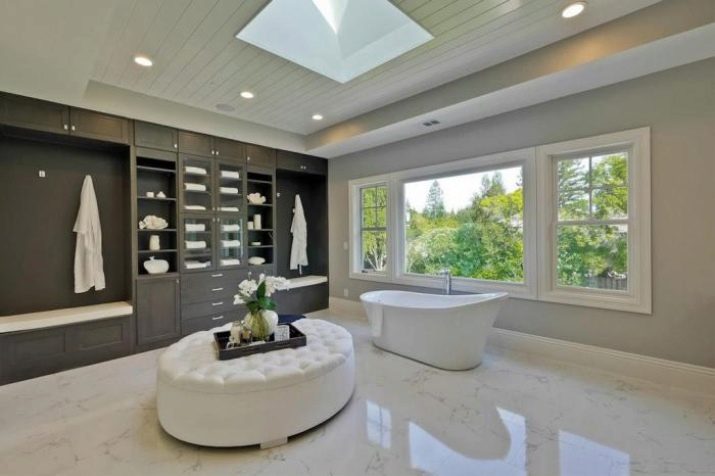
Plain single level ceiling, with accent chandelier and wide molding.

An example of combining tiles and stretch film in a modern style bathroom.
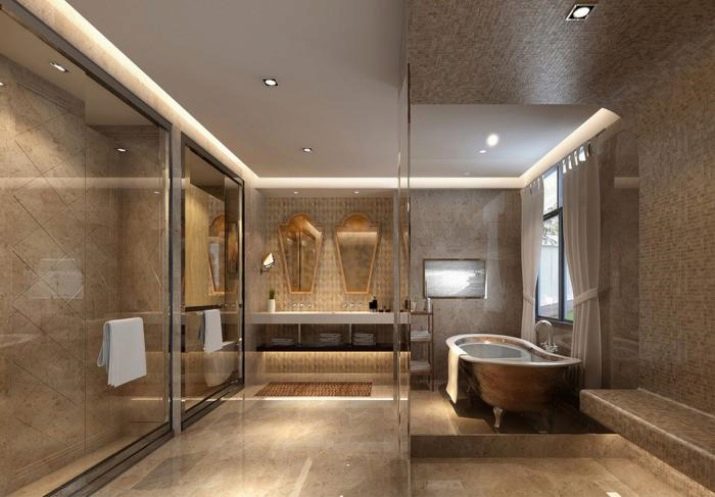
Cassette ceiling with mounted lights, made in the form of plates.
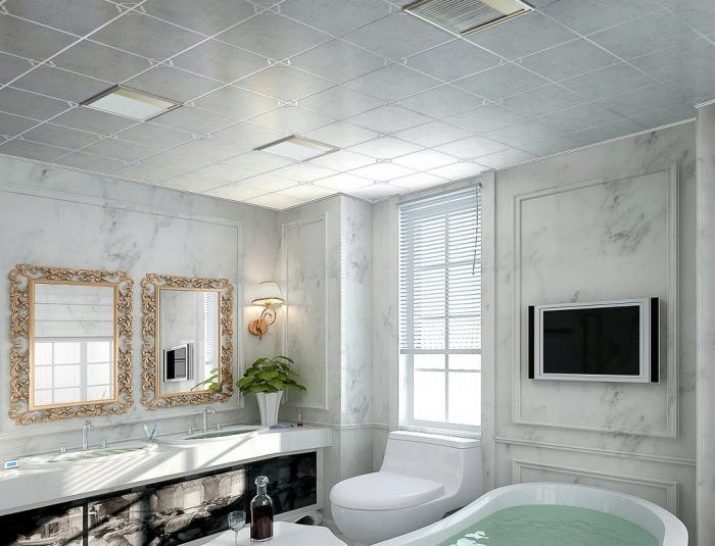
Installation of the ceiling from a plastic lining see below.
